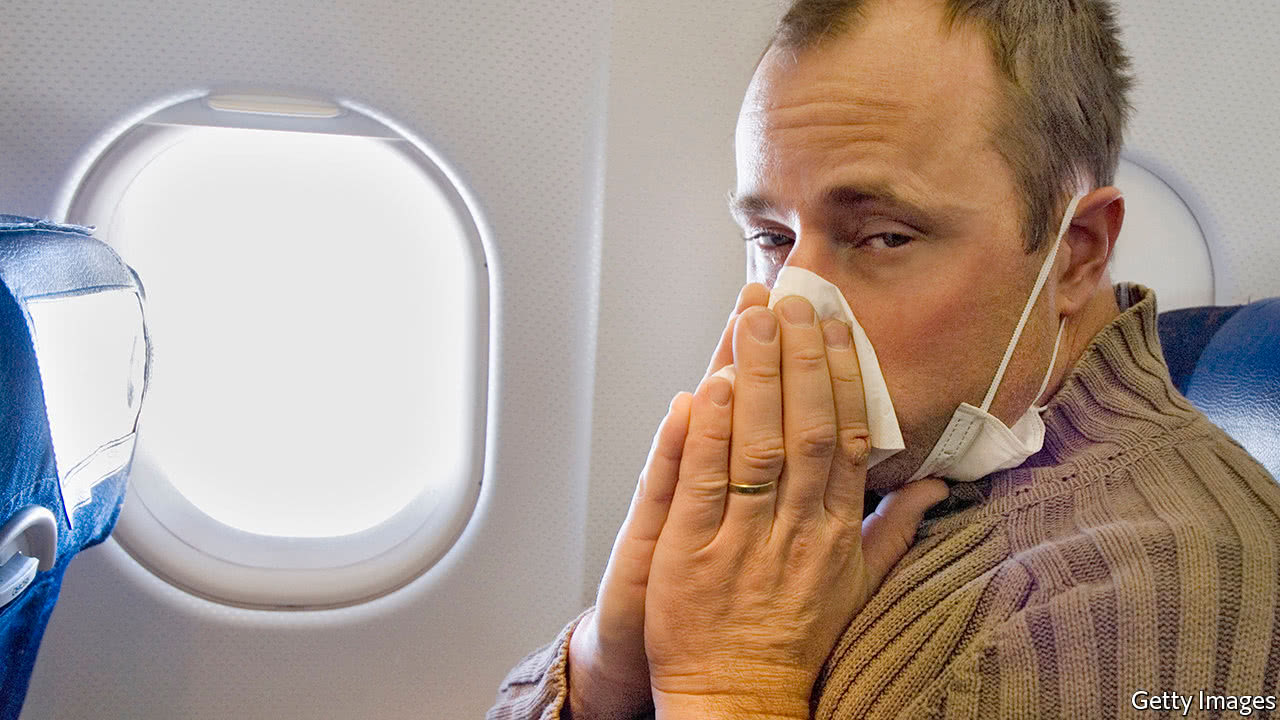
IT IS an often-heard office conversation. Someone returns from a trip with a nasty bug, and colleagues say he must have caught it from a germ-ridden plane. It is not unusual to come down with something nasty after flying. And as a fellow Gulliver reported last week, contaminated air on flights is widespread.
Someone has to carry those bugs into the cabin in the first place, before infecting fellow flyers. Researchers at Arizona State University, Florida State University and Embry-Riddle Aeronautical University have found that the way airlines board planes can have a huge effect on the potential for disease contagion. The researchers considered a hypothetical outbreak of the Ebola virus and the effect that different boarding methods could have on infection rates. With the standard boarding method of dividing the plane into three sections and boarding passengers from front to back, there is a 67% chance of reaching 20 or more air travel-related cases of Ebola per month, as passengers cluster together while waiting for the earlier boarders to stow their bags. It would be far better, the researchers found, to split the plane into two sections and board randomly within each section. In this scenario, the risk of infecting 20 people per month drops to 40%. (It would probably also make boarding quicker.)
-
How America botches executions using lethal injections
-
How hip-hop is introducing children to coding and technology
-
Why Roger Taney’s statue was removed from Maryland’s state house
-
Doctors trained at lower-ranked American medical schools prescribe more opioids
-
Emmanuel Macron finds change is often unpopular
-
Britain cannot escape the long arm of European law
The method of exiting the plane, the study found, is far less important, since it occurs much more quickly. But there is another significant factor: the size of the plane. Smaller planes—those with fewer than 150 seats—present a lower risk of disease transmission than larger ones, where the boarding process can be longer and more chaotic and there are also more people who can potentially be infected.
That means that during an outbreak like the Ebola epidemic that hit West Africa from 2014 to 2016, it might still be safe to run flights to and from the region, as long as the right precautions and procedures are in place. “Using smaller airplanes during an outbreak, instead of completely banning flights to a specific destination, can drastically reduce the probability of introduction of infection,” one of the researchers told an Arizona State University website.
The researchers hope their model can have far-ranging applications. It can easily swap Ebola for other epidemic diseases, such as influenza, or planes for other crowded modes of transportation, they say.
Flyers frequently complain about how cold it is on planes, and it is not uncommon for them to point to this as one reason passengers get sick. In fact, it is sometimes the opposite. Pilots turn down the temperature in order to prevent people from feeling ill. One commercial airline captain tells Condé Nast Traveler that he drops the thermostat dial when encountering turbulence in order to combat motion sickness. A study also found that higher cabin temperatures make it likelier that flyers will faint. (Another reasons for cool cabin temperatures is the comfort of the crew, who, in their work attire, are often dressed more warmly than vacationing passengers.)
Succumbing to an illness on a plane cannot always be helped. Sick people will continue to fly, and passengers cramped in close quarters means disease can spread easily—all the more so as seats are packed tighter together. But a better boarding process could at least reduce the risk of catching something unpleasant.
Source: economist
The way airlines board planes affects how easily bugs are spread among passengers